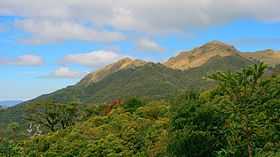Mount Pulag
| Mount Pulag | |
|---|---|
 | |
| Elevation | 2,922 m (9,587 ft)[1] |
| Prominence |
2,922 m (9,587 ft)[1] Ranked 106th |
| Listing | Ultra |
| Location | |
.svg.png) Mount Pulag | |
| Location | Luzon, Philippines |
| Coordinates | 16°35′0.86″N 120°53′0.93″E / 16.5835722°N 120.8835917°ECoordinates: 16°35′0.86″N 120°53′0.93″E / 16.5835722°N 120.8835917°E |
| Climbing | |
| First ascent | Unknown |
| Easiest route | Hike |
Mount Pulag (or sometimes Mount Pulog) is the third highest mountain in the Philippines. It is Luzon’s highest peak at 2,922 meters above sea level. The borders between the provinces of Benguet, Ifugao, and Nueva Vizcaya meet at the mountain's peak.
Because of its high elevation, the climate on Mount Pulag is temperate with rains predominating the whole year. Rainfall on the mountain averages 4,489 mm yearly with August being the wettest month with an average rainfall of 1,135 mm. Snow has not fallen on its top in at least the past 200 years.
The mountain hosts 528 documented plant species. It is the natural habitat of the endemic Dwarf Bamboo, (Yushania niitakayamensis) and the Benguet pine (Pinus insularis) which dominates the areas of Luzon tropical pine forests found on the mountainside. Among its native wildlife are 33 bird species and several threatened mammals such as the Philippine Deer, Giant Bushy-Tailed Cloud Rat (“bowet”) and the Long-Haired Fruit Bat. Mount Pulag is the only place that hosts the 4 Cloud Rat species. It has one of the most diverse biodiversity of the Philippines, with the newly found (since 1896) 185 grams Dwarf cloud rat, Carpomys melanurus, a rare breed (endemic to the Cordillera) and the Koch pitta bird among its endangered denizens.[2][3]
On February 20, 1987, a large part of the mountain was designated as a National Park with Proclamation No. 75. This act aims to preserve the environment around the mountain due to threats from increased development such as conversion to agricultural lands, timber production, hunting, and increased tourism.
The Ibaloi people of Benguet mummify their dead and house in caverns in the mountain. The Kabayan mummy burial caves, one of the main attraction of the site, is considered as Philippine National cultural treasures under Presidential Decree No. 374.[4]
Hiking activity
As the highest mountain in Luzon, Mount Pulag attracts a lot of mountain climbers. Highlights of the climb include the montane forests and the grassland summit with its "sea of clouds" phenomenon. There are four major trails up the summit: the Ambangeg, Akiki, and Tawangan trails from Benguet and the Ambaguio trail from Nueva Vizcaya. These trails are managed by the Mount Pulag National Park, under the Department of Environment and Natural Resources.
The National Park is inhabited by different tribes such as the Ibalois, Kalanguya, Kankana-eys, Karao, Ifugaos and the Ilocanos.
It is the third highest mountain in the Philippines, next to Mount Apo and Mount Dulang-Dulang
Presidential helicopter crash
On 7 April 2009 a Philippine Air Force (PAF) Bell 412 of the Presidential Airlift Wing crashed at 6,900 feet above sea level in the Kabayan-Pulag pass between Mount Mangingihi and Mount Pulag in thick low cloud and fog. The aircraft pilots and their passengers, who are presidential appointees, died in the crash.[5]
See also
- List of mountains in the Philippines
- List of national parks of the Philippines
- List of Southeast Asian mountains
References
- ↑ 1.0 1.1 de Ferranti, Jonathan; Maizlish, Aaron. "Philippine Mountains - 29 Mountain Summits with Prominence of 1,500 meters or greater". Retrieved 31 January 2011.
- ↑ "NUJP members climb Mt. Pulag for press freedom". GMA News Online. 20 April 2008. Retrieved 5 March 2012.
- ↑ Cariño, Delmar (26 April 2008). "Team finds rare cloud rat breed after 112 years". Inquirer.net. Retrieved 5 March 2012.
- ↑ Cariño, Delmar (27 April 2009). "Respect mummies, Pulag trekkers told". Inquirer.net. Retrieved 5 March 2012.
- ↑ Yagumyum, Rudy (16 April 2009). "PAF provides more details on presidential chopper crash". ABS-CBNNews.com. Retrieved 5 March 2012.
| |||||||||||||||||||||||||||||||||||
| |||||